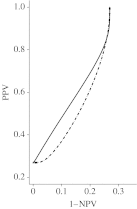The predictive receiver operating characteristic curve for the joint assessment of the positive and negative predictive values
- PMID: 18407893
- PMCID: PMC3227148
- DOI: 10.1098/rsta.2008.0043
The predictive receiver operating characteristic curve for the joint assessment of the positive and negative predictive values
Abstract
Binary test outcomes typically result from dichotomizing a continuous test variable, observable or latent. The effect of the threshold for test positivity on test sensitivity and specificity has been studied extensively in receiver operating characteristic (ROC) analysis. However, considerably less attention has been given to the study of the effect of the positivity threshold on the predictive value of a test. In this paper we present methods for the joint study of the positive (PPV) and negative predictive values (NPV) of diagnostic tests. We define the predictive receiver operating characteristic (PROC) curve that consists of all possible pairs of PPV and NPV as the threshold for test positivity varies. Unlike the simple trade-off between sensitivity and specificity exhibited in the ROC curve, the PROC curve displays what is often a complex interplay between PPV and NPV as the positivity threshold changes. We study the monotonicity and other geometric properties of the PROC curve and propose summary measures for the predictive performance of tests. We also formulate and discuss regression models for the estimation of the effects of covariates.
Figures










References
-
- Aerts, M., Geys, H. & Molenberghs, G. 2002 Topics in modelling of clustered data, ch. 6. Monographs on Statistics and Applied Probability no. 96. Boca Raton, FL: Chapman & Hall.
-
- Arnold B.C., Strauss D. Pseudolikelihood estimation: some examples. Sankhya Ser. B. 1991;53:233–243.
-
- Beam C.A., Conant E.F., Sickles E.A. Association of volume and volume-independent factors with accuracy in screening mammogram interpretation. J. Natl Cancer Inst. 2003;95:282–290. - PubMed
Publication types
MeSH terms
Grants and funding
LinkOut - more resources
Full Text Sources

